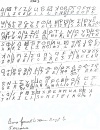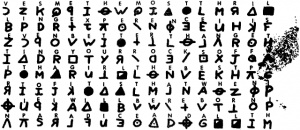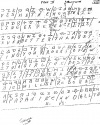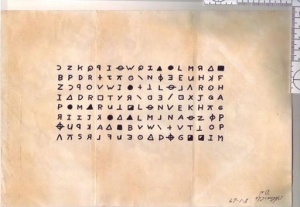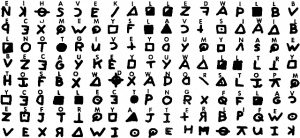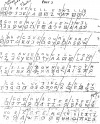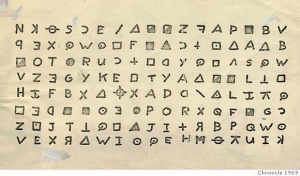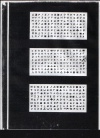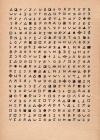Difference between revisions of "Solved 408-character cipher"
(→Images) |
(→Information, Analysis, Experiments) |
||
| Line 17: | Line 17: | ||
*[[Substring ranking]] - Can we apply measurements that give us a way to find interesting sections of cipher text for focused attacks? | *[[Substring ranking]] - Can we apply measurements that give us a way to find interesting sections of cipher text for focused attacks? | ||
*[[Catalog of repeating fragments]] - A comprehensive list of portions of cipher text that occur more than once in the cipher text. | *[[Catalog of repeating fragments]] - A comprehensive list of portions of cipher text that occur more than once in the cipher text. | ||
| + | *[[Corpus Experiments]] - A collection of corpus-based experiments performed on the Zodiac ciphers | ||
== Last 18 symbols of the 408 cipher == | == Last 18 symbols of the 408 cipher == | ||
Revision as of 05:41, 29 May 2012
Contents
Information, Analysis, Experiments
- Comparison of cipher alphabets
- Solution key
- Transcription of the letter and the Hardens' solution
- Donald and Bettye Harden's solution key. Part 1 | Part 2 | Part 3
- "Code key" sent to the Vallejo Police Department on August 10, 1969. This was unavailable to the general public until recently.
- Tabular version of the key
- Word frequency analysis of the 408 character cipher's plaintext
- Letter frequency analysis of the 408 character cipher's plaintext
- Levenshtein distance analysis - A look at the occurrences of repeated sequences that are not exact matches.
- Quadrant analysis - Do the n-gram counts improve If we split the cipher text into four quadrants?
- Quadrant analysis Part 2 - An expansion of the previous quadrant analysis experiment. Is it possible to produce quadrant arrangements that increase the number and quality of homophones detected algorithmically?
- Are the misspellings in the solution due to transcription errors?
- Omnidirectional repetitions - An investigation into patterns that repeat in arbitrary directions by following "snake-like" paths.
- "Complexification" - Did the cipher author begin with a simpler set of cipher symbols, then "complexify" certain symbols to further flatten the symbol distributions?
- Substring ranking - Can we apply measurements that give us a way to find interesting sections of cipher text for focused attacks?
- Catalog of repeating fragments - A comprehensive list of portions of cipher text that occur more than once in the cipher text.
- Corpus Experiments - A collection of corpus-based experiments performed on the Zodiac ciphers
Last 18 symbols of the 408 cipher
The last 18 letters of the decrypted plaintext are gibberish when using the same key that is used to decrypt the rest of the plaintext. What are the explanations for this?
- Possibility: The symbols were pulled down from symbols above the last row of the cipher text.
- Glurk's original proposal. There is good support for this explanation.
- Columnar repetition experiment. This tests how often random selections of the last 18 symbols would "accidentally" produce the same number of columnar repetitions (12) that we see in the original 408 cipher.
- Second experiment which includes repeated tetragram. This tests how often random selections of the last 18 symbols would "accidentally" produce the same number of columnar repetitions (12), where a tetragram repeats in the same column.
- Combinatorial calculation. This is a calculation of the probability that random selection of the last 18 symbols would produce columnar repetitions that are observed in the unmodified 408 cipher.
- Possibility: A plaintext message is encoded somewhere in the last 18 symbols, using some other system of encipherment.
Homophone sequences
- Homophone sequences - Several plaintext letters are assigned multiple homophones (ciphertext symbols) to conceal the language frequencies of the plaintext message. This page enumerates the sequences in which these homophones appear in the original ciphertext. What was the scheme used by the killer to select from the multiple homophones?
- Nick Pelling's articles on homophone sequences. Part 1 | Part 2
- John Graham-Cumming's article on automatic detection of homophone sequences
- John C. King & Dennis R. Bahler, "An Algorithmic Solution of Sequential Homophonic Ciphers". In their paper, King and Bahler describe an algorithm that can identify homophone sequences to simplify homophonic ciphers. Abstract
- Brute force search for homophone sequences - Shows sequences detected in the 408 and 340 ciphers by performing brute force searches for sequences involving up to 6 symbols.
Images
Images from Michael Butterfield (zodiackillerfacts.com) and Tom Voigt (zodiackiller.com):
Other images:

